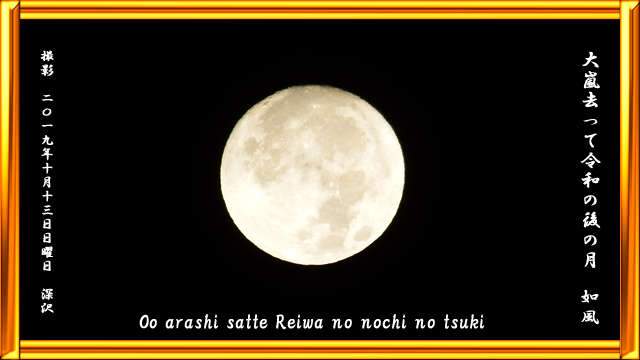2019/10/13 大嵐去って令和の後の月 如風選
プライマリータブ

(おおあらし さってれいわの のちのつき)
大きな嵐(台風19号)が去って、気が付けば、令和で最初の後の月が出ていました。季語:後の月(自解)
(Oo arashi satte Reiwa no nochi no tsuki)
After the violent storm(Typhoon No. 19), "nochi no tsuki of the new Imperial era,"Reiwa", is out. Kigo:nochi no tsuki(Explanation)
<The violent storm has gone. Oh! Now that "nochi no tsuki moon" is out, the first "nochi no tsuki moon" of Reiwa,new Imperial era. What a besutiful moon. What a relief!>(Interpretation of haiku)
【supplementation】
"Nochi no tsuki" is as the beautiful juugoya(15夜) moon of October as the juugoya moon of September which is looked upon as the most beautiful moon for the Japanese who like Haiku(俳句).
"Juugoya(15夜)" is the moon on the night of every month 15 according to the lunar calendar.
The new Imperial era,"Reiwa", has begun on May 1st in 2019.
The Imperial era name "Reiwa(令和)" was taken from “Manyoshu(万葉集)”, which is the oldest existing anthology of Japanese poetry, and is compiled sometime after AD 759 during the Nara period.
「初春の令月にして、気淑(よ)く風和ぎ、(hatsuharu no reigetsu ni shite , ki yoku kaze yawaragi)」(万葉集「梅花の歌」)⇒「令和」⇒「the happy and beauriful(令)moon(月)」+「the gentle and pacific(和)wind(風)」
- 参照(96)

